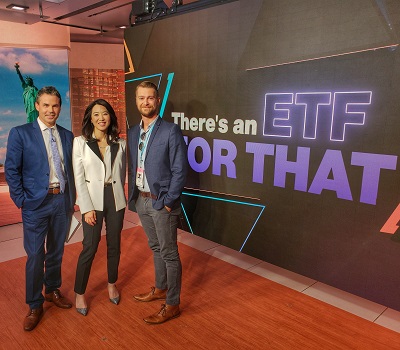(The fabulous Scarlet Fu and Eric Balchunas, hosts of ETF IQ)Here’s my appearance from yesterday on ETF IQ on Bloomberg TV in case you missed it. We touched on: 1) Why is the myth of passive investing important to understand? Short answer, but the longer-than-tv answer: passive has become a misnomer as anyone can construct an index fund in an active strategy and then claim to be “passively” tracking that index via an ETF. It’s easy to fall into the trap that passive is good and active is bad when the reality is that there’s a lot of active aspects of a passive fund and it’s easier to objectively analyze funds when we view everything as active and drop the sales pitch lingo. 2) Are the systemic risks of ETFs real? Short answer, but the longer-than-tv answer: There’s been a good deal of
Topics:
Cullen Roche considers the following as important: Myth Busting
This could be interesting, too:
Cullen Roche writes How Does the Fed “Manipulate” Interest Rates?
Cullen Roche writes Everything Wrong with the “Money Printer Go Brrrr” Meme
Cullen Roche writes The Scarcity of Money Myth
Cullen Roche writes Is Inflation Really 10%?

Here’s my appearance from yesterday on ETF IQ on Bloomberg TV in case you missed it. We touched on:
1) Why is the myth of passive investing important to understand?
Short answer, but the longer-than-tv answer: passive has become a misnomer as anyone can construct an index fund in an active strategy and then claim to be “passively” tracking that index via an ETF. It’s easy to fall into the trap that passive is good and active is bad when the reality is that there’s a lot of active aspects of a passive fund and it’s easier to objectively analyze funds when we view everything as active and drop the sales pitch lingo.
2) Are the systemic risks of ETFs real?
Short answer, but the longer-than-tv answer: There’s been a good deal of chatter in recent years about the systemic risks of passive index funds. The basic story says passive investors are lazy idiots who just bid up stock prices without doing any fundamental analysis, but this misunderstands how active a “passive” index fund actually is. While many people only see the “passive” buy and hold side of the trade they are missing the fact that there’s A LOT of activity on the other side of the trade because a less active investor relies on more active investors to make markets and supply the liquidity so they can be buy and holders. In other words, passive needs active and since there’s two sides to every trade it makes no sense to claim that passive indexers are mindlessly owning index funds when an index fund itself is a relatively active product that relies on active investors to make the product function.
3) Is the active mutual fund space dead?
Short answer, but the longer-than-tv answer: I basically think that the fund flows will continue to move into the ETF space because they’re generally better product wrappers. They’re usually more tax and fee efficient and they’re much more liquid. The liquidity is a double edged sword because it creates some behavioral risks and increases the risk of short-termism, but on the whole they’re better products. This does not mean the mutual fund space will go away. But it does mean that the financial industry will continue to move away from issuing management services inside the mutual fund wrapper.
4) Are the days of the 1% advisory fee going to last?
Short answer, but the longer-than-tv answer: I eat my own cooking on fees. The research is clear – fees have a devastating impact on investor returns. At the same time, I know that advisors provide a valuable service to people who have trouble building an appropriate portfolio that they can stay disciplined with. Advisors are, as I’ve noted, a lot like personal trainers. We aren’t here to turn you into this market beating version of Arnold Schwarzenegger. We’re here to keep you on the right path and make sure you don’t make big behavioral mistakes – especially at the times when so many people are losing their minds (like right now where everyone wants to pile full bore into US stocks or during bear markets when everyone wants out).
This is related to the passive debate as I’ve seen the industry change over time. A lot of advisors preach low fee, but aren’t really low fee. For instance, when I worked at big brokerage firms we didn’t charge a management fee, but most of our clients were invested in 1-1.5% c-share mutual funds. Our all-in cost was pretty close to 1.5% which is high. Most advisors these days have shifted away from c-share mutual funds to “passive” Vanguard ETFs, but they’re still charging a 1% management fee on top of that. So, if you’ve got a bunch of factor funds and things like that your all-in costs are still about 1.25%-1.5%. The narrative has changed to advisors using “passive” index funds, but the fees haven’t really dropped much.
Now, while I think these are valuable services (especially when combined with planning services) I do not believe they’re worth 1-1.5% per year. I just don’t. Sorry to all my friends who charge that or more! What are these services worth? Well, Vanguard actually argues they’re worth as much as 3%. I am not so sure. I’ve aligned my fees so that my average portfolio is comparable to what someone might pay their doctor, lawyer or other common service based industries. To me, 1%, which is the equivalent of TEN THOUSAND dollars per year on a million dollar account, is very high. The fees haven’t come down much yet, but I think they will with time.
That’s enough from me. Here’s the video if you’re interested (use this link for larger version):
